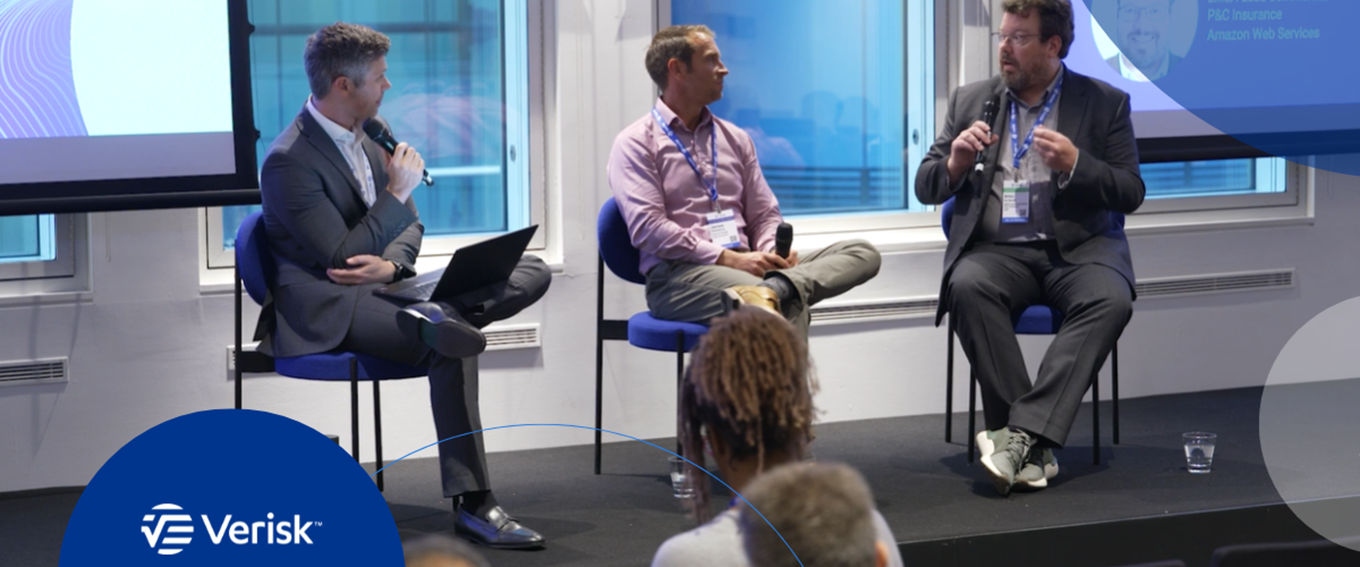Underwriters: navigating the technology terrain
Events -- 26 September 2024
Author: Marketing

What is a modern underwriter? This was the opening question that moderator Chris Spencer, director of underwriting at Verisk SBS, asked panelists James Sherborne, head of change at Inigo Insurance, and Arno de Wever, EMEA lead commercial P&C insurance at Amazon Web Services, during the recent Verisk Insurance Conference in London.
James Sherborne highlighted a significant shift over the past decade, with underwriters now adopting a more proactive approach to business opportunities. He said: “back then you would have an underwriter sitting in Lloyd’s waiting for business to reach them, the tables have turned to where we can now identify opportunities and bring a broker into them. And it’s business that’s found because of data we have.”
De Wever added that this data allows for “service pricing”, adding that “what we are seeing within the specialty market is that the data is now allowing for specific pricing for a client. What looks like a commoditised price is actually personalised, there’s an automation in the way that supply and demand is being looked at”. He added that underwriters still need to make the judgements, but additional data helps underpin those human decisions. For Sherborne this translates to underwriters needing to “use their gut, but they also need to complement that with data”.
Speed of service
Sherborne emphasised that the new generation of brokers and underwriters coming into the market are used to a high standard of service in their daily life. He stated that “when a carrier can't provide a risk price or a product price in a quick, reasonable time frame, any broker or client is going to think: what's going on behind the scenes? If Amazon can deliver me milk in 20 minutes, why can't you give me a price in a day?”
De Wever cited a study by AWS which found that the average time from submission to quote is 8 days, with a total of 20 days to move from submission to binding, with 2 of those days dedicated to entering information into underwriting systems. “Technology can help with shortening that. If you can give those hours back to an underwriter to actually make decisions, think of the productivity that can be gained there”, he added.
Artificial intelligence can also play a role in helping underwriters become more efficient, by structuring data that is unstructured into “something that is actually usable”, particularly for lines of business where a lot of information needs to be digested in order to get to an understanding of the risk. De Wever said that “if you look at, for example, energy, you tend to get engineering reports that can be hundreds of pages. We're seeing that some of our partners are able to create a summarisation of such documents which allows them to be read in a matter of minutes, and then they are able to go and ask clarifying questions to those documents”.
The underwriter of the future
A future-proof underwriter is expected to be well versed in analytics, leveraging data to create customised products. But they will still need to nurture and develop human relationships and connections. Sherborne said that “technology has evolved ridiculously quickly. But we are still humans. We haven't evolved at the same pace. We like that interaction with other humans. And I think that the future underwriter is someone who can take that data and can work on a human to human basis to articulate what that means to the client”. Spencer added that technology’s ability to free up time “allows underwriters to spend more time with brokers, therefore more time understanding the client, therefore more time writing the best risks while offering services like risk management and research”.
Another skill that will be a must have for underwriters is being able to shape products based on trends and data analysis. De Wever declared that “judgment is an integral aspect of being an underwriter, we need underwriters who understand data. Who are able to get specific information that is related to a risk or to a customer, and are able to build it into the profile that you need in order to make the right decisions. Underwriters need to be savvy enough to be able to do what technology is allowing nowadays.” Sherborne described this ideal underwriter as “someone who appreciates data, who can spot opportunities from data points, and can take that and articulate it in a way that non-insurance people can understand”.
Spencer closed the session by reminding the audience that when it comes to attracting talent, future underwriters are going to have expectations around technology. Having good systems to work on is going to be a differentiator, as underwriters will expect to have access to data that helps them make decisions and systems that ensure their time is free of intrusive, repetitive tasks, so they can focus on work that they are uniquely qualified to do.
Read Next
- 23 October 2025 - Events See you in Liverpool at GIRO Conference 2025
- 24 September 2025 - Events Verisk is sponsoring and presenting at InsTech’s Show and Tell
- 09 April 2025 - Events See you at TIN Delegated Authority Strategy Day
- 19 March 2025 - Events See you at the Dubai World Insurance Congress 2025